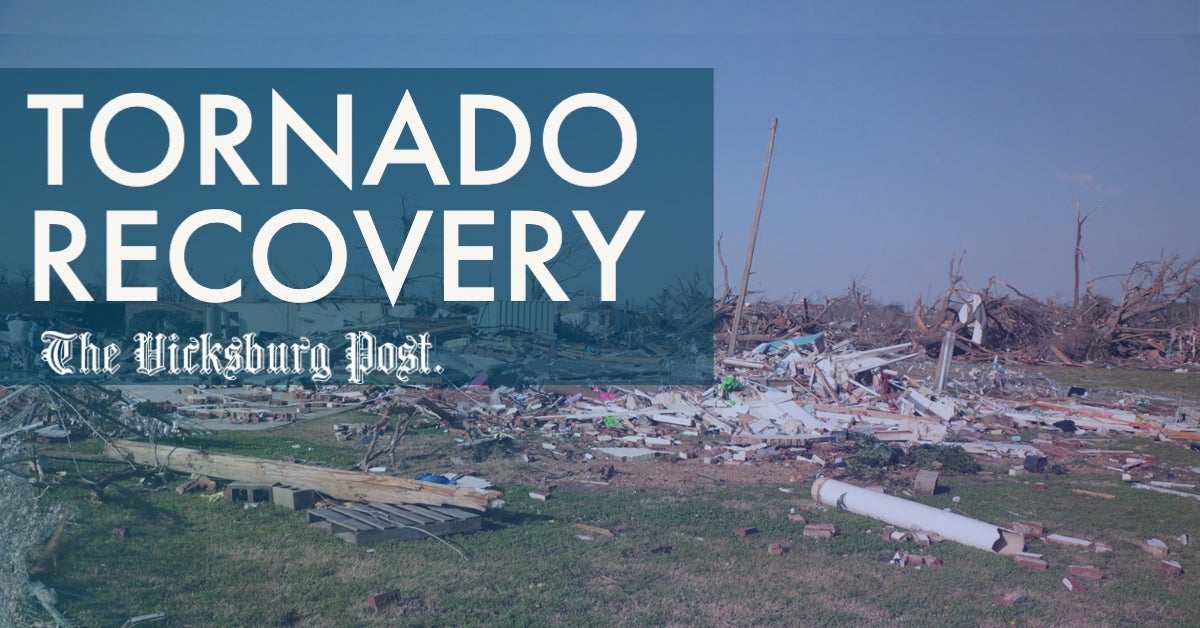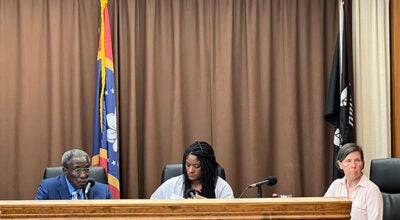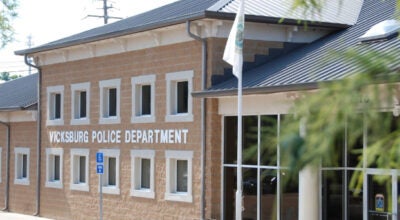As a Monster Tornado Bore Down, Many in the Mississippi Delta had no Chance for Shelter
Published 4:44 pm Wednesday, May 10, 2023
By Bracey Harris | NBC News, Special to The Vicksburg Post
The tornado that plowed through Rolling Fork on March 24 was a monster that families living in mobile homes on the plains of the Mississippi Delta needed to flee. At its widest, the dangerous twister careening through one of the nation’s poorest communities stretched three-quarters of a mile. At its strongest, its winds were powerful enough to flip mobile homes, hurl two-by-fours like javelins and collapse brick walls.
The safest place aboveground to ride out a storm that destructive is a tornado-safe room, a wind-resistant structure made of reinforced concrete. But there is no public tornado shelter in Rolling Fork — or in all of Sharkey County, where about a quarter of residences are mobile homes.
That left many people in this county, which is 71% Black, without protection as the storm bore down. While some hid where they could — in private storm cellars, in the closets and bathrooms of brick homes, in the walk-in refrigerator at Chuck’s Dairy Bar — others had no safe option. Fourteen people died.
“I do believe a lot of those people would have been alive if they would have had somewhere to go,” said Carrie Linda Mathews, who lives 8 miles south of Rolling Fork.
Her husband’s church lost a 56-year-old parishioner who was found dead in her mobile home, which had flipped upside down. “That’s the worst place you could be,” she said of mobile homes during a storm.
Mississippi doesn’t comprehensively track tornado shelters that are open to the public, and its list of the largest safe rooms isn’t available online. NBC News called emergency management directors and local officials in the 15 counties surrounding Sharkey County. According to those interviews, only six counties had at least one shelter that officials said was built to the Federal Emergency Management Agency’s guidelines.
Based on the survey, the closest public tornado shelter to Rolling Fork is in Morgan City, 53 miles away, where concrete vaults next to the small town’s fire station can hold an estimated 20 people. Families in Rolling Fork would have to drive about 71 miles to the town of Merigold to reach the nearest safe room with a capacity of more than 100 people.
This list is not definitive. Some counties also have shelters that are primarily used for first responders but may sometimes be open to the public. Some of the shelters NBC News found are more than a decade old and may require repairs. In Sharkey County, residents are mourning the storm’s victims and wondering whether a shelter could have saved lives that night. At least eight people who were killed in the tornado outbreak lived in mobile homes.
“The things I saw in this storm,” said Bill Newsom, the president of the county’s Board of Supervisors. “The mobile homes just didn’t have a chance. They were just wiped away.”
Tornado shelters can cost millions of dollars to build, which puts them out of reach of the Mississippi Delta’s poorest communities. A local emergency manager in another county said that even with a FEMA grant program covering 75% of the cost, county officials had opted not to apply because they didn’t have the budget.
A FEMA spokesperson said the agency has made significant investments in tornado shelters, having spent more than $158.5 million on 98 community safe rooms in 44 of Mississippi’s 82 counties since 2008. The Biden administration also invested more than $2 billion in a FEMA program to help communities better prepare for disasters and climate change, covering 90% of costs in rural areas considered economically disadvantaged. But Malary White, a spokesperson for the Mississippi Emergency Management Agency, said there are communities in the state that would struggle to contribute 10% matches for safe rooms.
“This is a conversation we’ve had with FEMA,” she said. “Our counties have said they simply cannot afford it.”
White added that the agency used to share an online map of safe room locations but took the guide down after it heard that sites weren’t always open. Now, addresses are posted online when counties report the rooms are open for severe weather. Craig Fugate, a former administrator of FEMA, said that beyond the federal government, state governments, too, have a role to play in funding disaster preparedness. He’s concerned that there’s a resiliency divide hindering the ability of disadvantaged communities to prepare for storms and rebuild afterward.
“The consequences are more people are going to die, more people are going to suffer,” he said.
Robert Barfield, a Rolling Fork police officer, had only a few hours left in his shift on March 24, a Friday evening, when he looked out over a field and saw the tornado’s wedge lit up by lightning. Barfield, 24, could barely see through the sheets of rain, but he could make out the telephone poles snapping in front of him. The wind was so strong he couldn’t open the door of his patrol car to get out. He rode out the storm in the cruiser, covering his head with his hands as the vehicle rocked. When it was over, he was dispatched to a mobile home park just off U.S. Highway 61.
The lots where residents once lived were “just disintegrated, just gone,” he said.
Barfield saw a boy he recognized from the local Little League team limping amid the ruin. “Robert, I can’t breathe,” the child told him. “I’m scared.” Barfield tried to help the boy before he was taken to the hospital. He had a collapsed lung but survived.
Then Barfield heard from another officer that he needed to check on his aunt. She lived a mile to the south, in Rolling Fork’s Blue Front neighborhood. Mary Barfield Bush, 56, had settled in for the night when the storm hit, flipping her mobile home upside down and pinning her under a mattress. When Barfield arrived, he had to step over debris and climb through a hole that had been ripped in the home’s side. The other officer had already warned him that his aunt might not have survived, but Barfield needed to be sure of it himself. That’s what he would have wanted if it were his mom.
“I wasn’t letting anybody tell me anything,” he said.
Barfield took her wrist to check her pulse. She was gone. Barfield realized he needed to keep moving. The floor of his aunt’s battered trailer was now the ceiling, and it could cave in. And more people needed help.
“I had a duty to go to the next house,” Barfield said.
He kept working until Sunday morning. What he witnessed makes him believe Rolling Fork should have a public tornado shelter, so those who find it unsafe to remain in their homes won’t have to.
“Even if they lose their homes, they don’t lose their lives,” he said.
Lequita Barfield, 36, Bush’s daughter, is unsure whether her mother would have gone to a shelter that night if one had been available.
“We always think it’s going to blow over. We never expect to see it where we live,” she said.
She still can’t believe her mother is gone. Bush worked as a caregiver and had a smile that “lit up the room,” she said. At get-togethers, Bush liked to sing and get people up to dance.
“I’m trying to handle it the best way I know how,” Lequita Barfield said. “This is the worst thing I’ve ever had to deal with. It hurts.”
To the north of Bush’s neighborhood, Sammie Jackson was in his wood-frame house on Walnut Street when the storm leveled it, leaving only the floor intact. During the twister, he tried to cover himself with a mattress, alongside a friend who had come over with her daughter and grandbaby. The wind stripped the mattress away. He thinks they’re “blessed” to have escaped without serious injuries but wishes they’d had somewhere to go that was designed to withstand life-threatening winds
“If we had a shelter, that’s where we would have gone,” he said.
For now, Jackson, 61, is staying in a hotel in Greenville, about 40 miles away.
“Now that we went through that, you get spooked when you hear the wind’s going to be high,” he said. “That’s going to be on our mind for a long time.”
None of the counties bordering Sharkey County has a public tornado shelter, according to NBC News’ survey. One of the nearest options built to FEMA’s criteria is about an hour’s drive away in Boyle, in Bolivar County. Boyle Police Chief Murry Roark was surprised to find out that the shelter — a small concrete pod that can accommodate about 20 people — was one of the closest shelters for Sharkey County’s nearly 3,500 residents.
He believes every county needs a safe room. It’s not uncommon, he said, to see houses in the Mississippi Delta that aren’t “storm-resistant, much less stormproof.”
“Just for the peace of mind it’s worth it,” Roark said. “It could very easily save your life.”
On the evening of March 24, Roark was sitting in Darry’s Food-n-Drink on T M Jones Highway when patrons approached wanting to know whether he was keeping up with the weather. Much of the Mississippi Delta region had been alerted that tornadoes were possible.
Just in case, he decided to check on the concrete pod, which was installed about a decade ago just a few feet to the side of the diner. He found it locked. Roark knocked, and when the door opened, he was surprised to see that a few people had already gathered inside and that some of them were crying. Roark tried to reassure them they would be OK.
“Nothing is going to happen to y’all,” he said, and he was right — Boyle was spared from the tornado’s path. Washington County, which neighbors Bolivar, is home to about 42,500 people but lacks a public tornado shelter.
David Burford, the county’s emergency management director, urges residents to look out for one another. People who live in sturdier homes than their neighbors might consider taking them in during storms. About 28% of residents in Washington County live in poverty. In the past, the county’s Board of Supervisors decided not to seek FEMA funds to build a safe room because of the cost.
“Funding’s the reason for everything, unfortunately,” Burford said.
He noted that the need for safe rooms across Mississippi is enormous.
“Can the federal government even afford to do that?” he asked.
Burford paused. A better question, he said, might be “Why don’t they find a way to do this?”
More than a decade after an EF4 tornado killed four people in Yazoo County, which is Mississippi’s largest by land area, the county is still without a public safe room. And the threat hasn’t gone away: At least seven tornadoes have been recorded in the county in the past three years. Jack Willingham, the county’s emergency management director, said his office got an influx of calls from residents wanting to learn more about safe rooms following the devastation in Rolling Fork. He said it would be a challenge for the county to pay for a public one, but he’s trying to see what’s possible.
“If it saves one life, it would be worth it,” he said. “How do you value that?”
A ‘complicated’ answer. Public shelters alone aren’t enough to keep communities safe during tornadoes.
About 13% of households in Sharkey County don’t have vehicles, according to census data, which could make it difficult to travel. Those with hourly jobs might not be able to take time off to wait out a storm advisory in a shelter. And people who leave for safe rooms without enough lead time may put themselves in an even more dangerous situation if they’re on the road when tornados hit. People may be turned away if demand dangerously exceeds a room’s capacity.
“Public shelters are complicated,” said Harold Brooks, a senior research scientist with the National Oceanic and Atmospheric Administration.
Brooks said that in an “ideal world,” everyone would have a shelter within 100 feet of where they live.
FEMA has spent almost $21.6 million on a Mississippi program helping homeowners build nearly 7,000 residential safe rooms since 2008. But renters aren’t eligible for the funds, and neither are mobile home residents who don’t own their land. That’s where public shelters can play a role, offering protection for those with nowhere else to go.
In Sharkey County, Newsom said he plans to raise the idea of building a public tornado shelter. But he acknowledged the county already faces hard financial realities after the storm. One of Sharkey County’s most recent annual budgets was about $3.5 million. Depending on its size, a safe room can easily cost hundreds of thousands of dollars, even with FEMA’s match.
“We’re too small. We just don’t have enough industry,” he said, reflecting on the county’s need for assistance in preparing for future storms. “And now our tax base is going to be stretched even worse.”
But he believes the community needs an option, like the one he was fortunate to have that night. Newsom and his wife fled to their home’s storm cellar after he got a text from someone he knew warning, “Take cover now, tornado.”
Newsom’s home is among the ones in town still standing, but the windows blew out. Wood splinters that looked like spears were strewn about inside.
He knows that if they had huddled in the den, they wouldn’t have come out unscathed. Even underground, the couple could hear the maelstrom. “It was — I’m telling you it was a violent storm,” he said.






